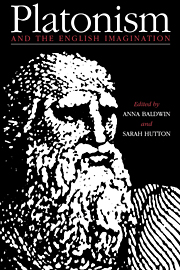Book contents
- Frontmatter
- Contents
- Notes on contributors
- Preface
- I ANTIQUITY
- II THE EARLY CHRISTIAN PERIOD AND THE MIDDLE AGES
- III THE RENAISSANCE AND THE SEVENTEENTH CENTURY
- IV THE EIGHTEENTH CENTURY
- V THE NINETEENTH CENTURY
- 18 Introduction
- 19 Recollection and Recovery: Coleridge's Platonism
- 20 Wordsworth's Ode on the Intimations of Immortality
- 21 Shelley, Plato and the political imagination
- 22 Arnold, Plato, Socrates
- 23 Flux, rest and number: Pater's Plato
- VI THE TWENTIETH CENTURY
- Bibliography
- Index
19 - Recollection and Recovery: Coleridge's Platonism
Published online by Cambridge University Press: 15 December 2009
- Frontmatter
- Contents
- Notes on contributors
- Preface
- I ANTIQUITY
- II THE EARLY CHRISTIAN PERIOD AND THE MIDDLE AGES
- III THE RENAISSANCE AND THE SEVENTEENTH CENTURY
- IV THE EIGHTEENTH CENTURY
- V THE NINETEENTH CENTURY
- 18 Introduction
- 19 Recollection and Recovery: Coleridge's Platonism
- 20 Wordsworth's Ode on the Intimations of Immortality
- 21 Shelley, Plato and the political imagination
- 22 Arnold, Plato, Socrates
- 23 Flux, rest and number: Pater's Plato
- VI THE TWENTIETH CENTURY
- Bibliography
- Index
Summary
The influence of Platonic thought on Coleridge is felt in almost every area of his work. In this chapter I shall consider only the way in which Coleridge used Plato's theory of ideas, and his theory of knowledge as recollection. He re-defined these in the light of his reading of the German transcendental idealist philosophers, notably Immanuel Kant. The intensive study of Kant which he undertook in the years following 1800 confirmed Coleridge in his opposition to the British empiricist tradition. It supplemented, but did not supplant, the study of Plato and the Neoplatonists. Plato and Kant both provided him with ammunition which he could use against the ‘mechanical philosophy’ as he generally called the complex of ideas centring upon the associationist psychology of David Hartley and the epistemology of impressions and ideas developed by Locke and Hume. Coleridge had two main objections to this system. It treats the mind as essentially passive; and it reduces the mind to a collection of disparate ideas loosely tied together by association and memory. Plato was central to the shaping of Coleridge's response to these perceived limitations of the empiricist position. Coleridge saw in him, as Shelley did also, the supreme example of the philosopher as poet. Plato's writings are in themselves ‘poetry of the highest kind’. As such, I shall argue, their value for Coleridge lay not in any specific Platonic doctrine, important though these were. It consisted rather in their ability to elicit an imaginative and creative response from the reader. The active nature of this response differs radically from the eighteenth-century empiricist model which conceived the mind as a tabula rasa, able only to receive the impressions made on it by objects in the external world.
- Type
- Chapter
- Information
- Platonism and the English Imagination , pp. 207 - 216Publisher: Cambridge University PressPrint publication year: 1994
- 1
- Cited by

